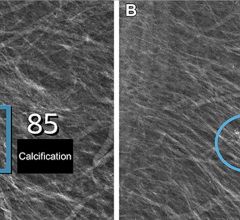December 18, 2012 — The addition of 3-D breast imaging, or tomosynthesis, to standard digital mammography significantly increases radiologists’ diagnostic accuracy while reducing false positive recall rates, according to the results of a multicenter study published in Radiology.
“This is the first major advance in breast imaging and breast cancer screening since the development of breast MRI,” said lead researcher Elizabeth A. Rafferty, M.D., director of breast imaging at the Avon Comprehensive Breast Center at Massachusetts General Hospital in Boston. “The beauty of tomosynthesis is that it addresses two major concerns with screening mammography: missed cancers and false positive rates.”
According to the National Cancer Institute, there is convincing evidence that screening mammography reduces breast cancer mortality in women between the ages of 40 and 74. However, as many as 30 percent of breast cancers are not detected by mammography, and an additional eight to 10 percent of women who undergo a screening mammogram are recalled for further testing when no cancer is present (called a false positive result).
Unlike a screening digital mammogram, which involves two X-ray images of each breast, breast tomosynthesis captures multiple, low-dose images from different angles around the breast. The images are then used to produce a 3-D reconstruction of the breast. Both digital mammography and breast tomosynthesis, which was approved by the U.S. Food and Drug Administration (FDA) in February 2011, can be performed on the same mammography equipment in rapid succession.
Rafferty’s study involved 1,192 women recruited from five sites, of whom 997, including 780 screening cases and 217 women who needed pre-biopsy breast imaging, had complete datasets. Each of the women underwent a standard digital mammogram followed by breast tomosynthesis. The total radiation dose for the combined procedure was less than 3 Gy, which is the FDA limit for a single mammogram.
Drawing from the eligible cases, the researchers then conducted two reader studies involving 312 and 310 cases, respectively. Twelve radiologists participated in the first reader study; 15 radiologists in the second. A total of 48 cancers were included in the first reader study; 51 cancers in the second.
Compared to digital mammography alone, the use of both standard mammogram and tomosynthesis resulted in increased diagnostic accuracy for all 27 radiologists. Additionally, the diagnostic sensitivity of the combined exam — or the rate at which cancer present in the breast was correctly identified — increased by 10.7 percent for radiologists in Reader Study 1 and 16 percent for radiologists in Reader Study 2.
“Almost all of the gains in diagnostic sensitivity with the combined modality were attributable to the improved detection and characterization of invasive cancers, which are the cancers we are most concerned about because of their potential to metastasize,” Rafferty said.
With the addition of breast tomosynthesis to standard digital mammography, false positive recall rates also significantly decreased for all 27 of the radiologists. Absolute recall rate reductions of 38.6 percent and 17.1 percent were seen in Reader Studies 1 and 2, respectively.
“In the clinical setting, we would expect that type of reduction in recall rate to translate into a substantial number of unnecessary diagnostic tests being avoided,” Rafferty said.
For more information: www.radiology.rsna.org


 July 29, 2024
July 29, 2024 








